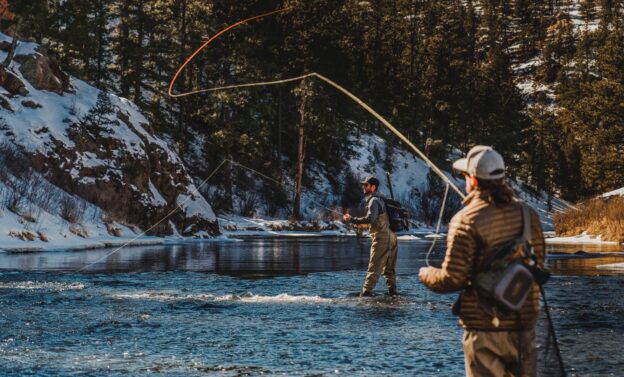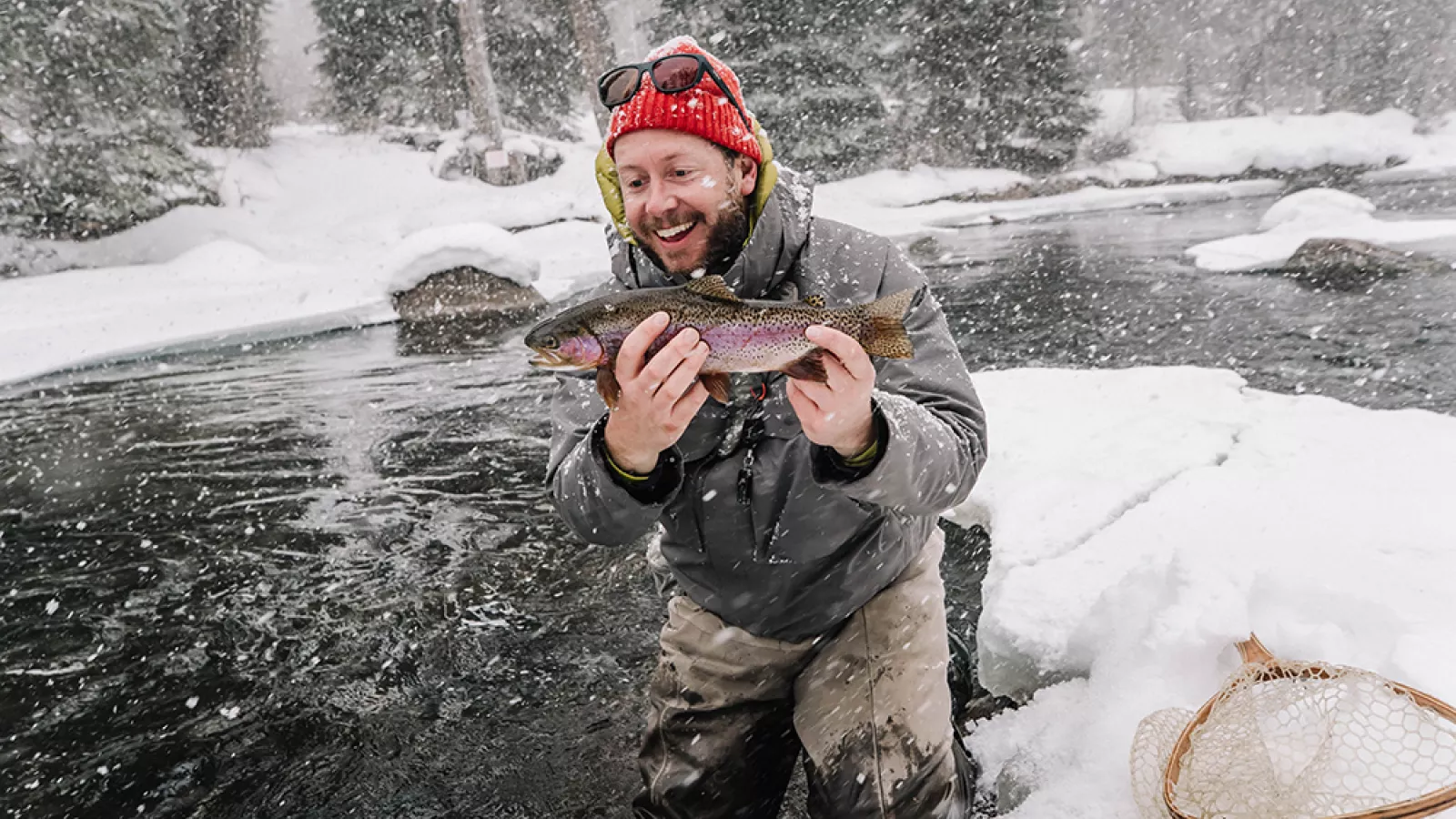So you’re interested in getting started with fly fishing? Well, you’re in for an exhilarating adventure! Whether you’re a seasoned angler looking to try something new or a complete beginner eager to cast your first line, this article will guide you through the basics of fly fishing. From choosing the right equipment to mastering the art of casting, we’ll help you embark on a journey that will immerse you in nature, challenge your skills, and introduce you to a whole new world of angling possibilities. So grab your fishing rod, tie on a fly, and let’s dive into the wonderful realm of fly fishing together!

Choosing the Right Equipment
When it comes to fly fishing, selecting the right equipment is crucial to ensure a successful and enjoyable experience. Here are some key factors to consider when choosing the right fly rod, reel, line, leader, and tippet.
Selecting the Right Fly Rod
The fly rod is the centerpiece of your fly fishing equipment. When selecting a fly rod, it’s important to consider the type of fishing you plan to do and the species of fish you’ll be targeting. Fly rods come in different lengths, weights, and materials, each suited for specific fishing conditions.
If you’re a beginner, it’s recommended to start with a medium-action fly rod with a weight of 5 to 6. This will provide you with the versatility and control needed to learn and develop your casting techniques. As you gain more experience and specialize in different types of fly fishing, you can invest in rods designed specifically for those purposes.
Choosing the Appropriate Fly Reel
While the fly reel may not have as significant an impact on your fishing experience as the rod, it’s still an important piece of equipment that shouldn’t be overlooked. The primary function of the reel is to hold the fly line and provide a smooth drag system to control the fish.
When choosing a fly reel, consider the weight of the rod and the size of the fish you’ll be targeting. Look for reels that have a durable construction and a reliable drag system. It’s also important to choose a reel that balances well with your rod for comfortable handling.
Picking the Right Fly Line
The fly line is what allows you to cast your fly to the target and manipulate it in the water. It’s important to choose a fly line that matches the weight and action of your rod for optimal performance. The most common types of fly lines are weight-forward, double-taper, and sinking lines.
Weight-forward lines are versatile and easy to cast, making them a great choice for beginners. Double-taper lines are more precise and delicate, perfect for delicate presentations. Sinking lines, on the other hand, are designed for fishing at different depths.
Consider factors such as fishing conditions, target species, and personal preferences when choosing a fly line. It’s also a good idea to consult with experienced anglers or visit a fly fishing shop for guidance.
Selecting the Proper Leader and Tippet
The leader and tippet are the final components of the fly fishing setup. The leader is a tapered section of monofilament or fluorocarbon line that connects the fly line to the fly. It helps to transfer energy from the fly line to the fly, ensuring a smooth and accurate presentation.
The tippet is the thinnest section of the leader and serves as the connection between the fly and the rest of the leader. It’s important to choose a leader and tippet that is appropriate for the size of the fly and the fish you’ll be targeting. Thicker leaders are suitable for larger flies and stronger fish, while thinner leaders are more suitable for smaller flies and delicate presentations.
Consider the fishing conditions, target species, and the size of the flies you’ll be using when selecting the proper leader and tippet. It’s also important to regularly check and replace your leader and tippet as they can become worn or damaged over time.
Understanding the Basics of Fly Fishing
Before heading out to the water, it’s important to understand the basics of fly fishing. This includes learning about the different types of flies, mastering casting techniques, and understanding entomology and fish feeding behavior.
Learning the Different Types of Flies
The fly is the artificial bait used in fly fishing. There are three main types of flies: dry flies, nymphs, and streamers. Each type is designed to imitate a particular food source or provoke a specific reaction from the fish.
Dry flies are designed to float on the water’s surface and imitate adult insects or other small creatures. They are particularly effective when fish are actively feeding on the surface.
Nymphs are designed to imitate aquatic insect larvae that live underwater. They are fished beneath the surface using techniques such as nymph fishing or dead-drift presentations.
Streamers are larger flies designed to mimic small fish or other large prey items. They are typically fished using an active retrieval technique and are effective for targeting predatory fish.
Understanding the different types of flies and their specific uses will help you choose the right fly for different fishing situations and increase your chances of success on the water.
Understanding the Importance of Casting Techniques
Casting is a fundamental skill in fly fishing. It’s the process of propelling the fly line, leader, and fly to the intended target. Good casting techniques allow you to accurately and delicately present the fly to the fish, improving your chances of a successful catch.
There are different casting techniques in fly fishing, but the most common and basic one is the overhead cast. To perform an overhead cast, you need to master the basic mechanics, such as the backcast, forward cast, and stopping at the right point.
Practice your casting techniques regularly to improve your accuracy and distance. Consider taking casting lessons or watching instructional videos to learn proper casting form and technique. Remember, casting is a continuous learning process, and even experienced anglers can always refine their skills.
Learning About Entomology and Fish Feeding Behavior
Understanding entomology, or the study of insects, and fish feeding behavior is crucial for successful fly fishing. Knowing what insects are present in the water and what the fish are feeding on will help you select the right fly and present it in a way that triggers the fish’s feeding response.
Spend time observing the water and the insect activity before you start fishing. Look for signs of fish feeding, such as rising fish or insect activity on the surface. By closely observing the water and the fish’s behavior, you can make educated guesses about what flies to use and how to present them.
Consider carrying a fly fishing entomology guide to help you identify the different insects and their life stages. This knowledge will greatly enhance your decision-making process when it comes to fly selection and presentation.
Selecting the Perfect Fishing Spot
Choosing the right fishing spot is crucial for a successful fly fishing expedition. Here are some tips to help you identify suitable bodies of water, consider different types of fisheries, and understand seasonal patterns of fish.
Identifying Suitable Bodies of Water
When choosing a fishing spot, it’s important to consider the type of water you’ll be fishing in. Fly fishing can be done in various bodies of water, including rivers, streams, lakes, and ponds, each with its own unique characteristics and fishing opportunities.
Rivers and streams are dynamic and offer a diverse range of fishing conditions. They provide opportunities to fish for a variety of species and often have accessible public access points. Lakes and ponds, on the other hand, offer a more serene and peaceful fishing experience. They can be home to larger species and provide opportunities for boat or float tube fishing.
Whether you choose to fish in moving water or still water, consider factors such as accessibility, fish species, fishing regulations, and personal preferences when selecting a suitable body of water.
Considering Different Types of Fisheries
Different types of fisheries exist, each with its own set of rules and regulations. It’s important to familiarize yourself with these different types to choose the one that aligns with your fishing goals and preferences.
Public fisheries are typically open to anyone with the necessary fishing licenses and permits. They are often well-maintained and offer good opportunities for catching fish. Private fisheries, on the other hand, require a membership or day pass and often offer exclusive access to high-quality fishing grounds.
Catch-and-release fisheries are designed to conserve fish populations and promote sustainable fishing practices. These fisheries often have specific regulations, such as using barbless hooks and practicing proper fish handling techniques.
When choosing a fishing spot, consider the type of fishery that suits your needs and preferences. Research local regulations and guidelines to ensure you are fishing within the legal limits and practicing ethical angling.
Understanding the Seasonal Patterns of Fish
Fish behavior and feeding patterns can vary throughout the year, depending on the season and environmental factors. Understanding these seasonal patterns can greatly increase your chances of a successful catch.
In the spring, fish are often more active and willing to feed as they emerge from their winter hibernation. This is a great time to target hungry fish that are eager to take a well-presented fly.
During the summer months, fish may become more selective and seek cooler, deeper waters. It’s important to adjust your fly selection and presentation to match the changing conditions.
In the fall, fish are preparing for winter and can become more aggressive in their feeding. This is a great time to target larger fish that are actively feeding to build up their energy reserves.
Winter fishing can be challenging, as fish become less active and seek shelter in deeper, slower-moving waters. However, with the right techniques and fly selection, it is still possible to have success on the water.
Research local fishing reports, talk to experienced anglers, and observe the behavior of fish and insects when planning your fishing trips. By understanding the seasonal patterns of fish, you can increase your chances of connecting with a trophy catch.

Mastering the Essential Fly Fishing Knots
Learning and mastering essential fly fishing knots is essential for a successful and enjoyable fishing experience. Here are some important knots to add to your repertoire.
Learning the Improved Clinch Knot
The improved clinch knot is one of the most commonly used knots in fly fishing. It’s used to tie the fly to the tippet and provides a strong and reliable connection.
To tie an improved clinch knot, start by passing the end of the tippet through the eye of the fly hook. Wrap the tag end of the tippet around the standing line five to seven times. Then, thread the tag end back through the loop formed above the eye of the fly hook. Wet the knot with water or saliva and tighten it by pulling both ends of the tippet.
Mastering the Arbor Knot
The arbor knot is used to attach the fly line to the reel’s arbor. It’s important to have a secure connection between the fly line and the reel to prevent any slippage during casting and fighting a fish.
To tie an arbor knot, start by passing the end of the fly line through the reel’s arbor. Make a simple overhand knot around the standing line, leaving a small loop. Pass the end of the fly line through the loop and make another overhand knot. Wet the knot with water or saliva and tighten it by pulling both ends of the fly line.
Understanding the Blood Knot Technique
The blood knot is frequently used to join two sections of leader or tippet material. It creates a strong and smooth connection that won’t hinder the fly’s movement through the water.
To tie a blood knot, start by overlapping the two sections of leader or tippet material. Take the tag end of the first section and wrap it around the standing line of the second section five to seven times. Then, thread the tag end back through the loop formed between the two sections. Wet the knot with water or saliva and tighten it by pulling both ends of the leader or tippet material.
Perfecting the Surgeon’s Knot
The surgeon’s knot is a versatile knot that can be used to join two sections of leader or tippet material of different diameters. It’s a quick and easy knot to tie and provides a strong connection.
To tie a surgeon’s knot, start by overlapping the two sections of leader or tippet material. Cross the tag end of one section over the standing line of the other section, forming a loop. Wrap the tag end around the standing line and pass it through the loop two times. Wet the knot with water or saliva and tighten it by pulling both ends of the leader or tippet material.
Practice tying these knots regularly to build muscle memory and ensure you can tie them confidently and quickly on the water. It’s also a good idea to carry a knot-tying guide or refer to online resources for detailed instructions and diagrams.
Getting Familiar with Common Fly Fishing Techniques
Fly fishing offers a range of techniques that can be used to target different fish species and fishing conditions. Here are some common techniques to explore.
Exploring Dry Fly Fishing
Dry fly fishing is one of the most exhilarating and visually appealing techniques in fly fishing. It involves fishing with floating flies that imitate adult insects or other small creatures resting on the water’s surface.
To fish with dry flies, cast the fly upstream or across the current and let it drift naturally on the water’s surface. Watch for any rises or sudden movements indicating a fish has taken the fly. Once a fish takes the fly, set the hook by gently lifting the rod.
Dry fly fishing requires careful observation and precise casting to present the fly naturally. It’s important to match the size and color of the fly to what the fish are feeding on and to make the fly appear as lifelike as possible.
Understanding Nymph Fishing
Nymph fishing is a technique used to fish with imitations of aquatic insect larvae that live underwater. Nymphs are an important food source for fish, and fishing with nymphs can be highly productive.
To fish with nymphs, cast the fly upstream or across the current and allow it to sink to the desired depth. Use weight or split-shot to help the fly sink, if needed. Manipulate the fly by using various techniques, such as dead-drifting or adding slight twitches to imitate the natural movement of the nymph.
Nymph fishing requires a delicate and sensitive presentation. It’s important to watch the tip of the fly line or use indicators to detect any subtle strikes. When you see a strike or feel a slight tug, set the hook by lifting the rod tip gently but quickly.
Trying Out Streamer Fishing
Streamer fishing is a technique used to imitate larger prey items, such as small fish or other large creatures, that attract predatory fish. Streamers are designed to mimic the movement and profile of these prey items.
To fish with streamers, cast the fly across the current or downstream and retrieve it with short, quick strips, imitating the swimming and darting action of the prey. Vary your retrieval speed and depth to find what triggers the fish’s feeding response.
Streamer fishing often requires a more aggressive presentation and can be physically demanding. By using larger, heavier rods and lines, you can cast larger, bulkier streamers and cover more water effectively.
Explore these different fly fishing techniques and experiment with different flies, retrieves, and presentations to find what works best for the fish species and fishing conditions you encounter.
Gearing Up with the Right Fishing Accessories
To make your fly fishing experience more enjoyable and productive, it’s important to gear up with the right fishing accessories. Here are some essential accessories to consider.
Investing in a Quality Fly Box
A fly box is essential for storing and organizing your flies. Look for a fly box with compartments or slots that can hold your flies securely and prevent them from getting tangled or damaged. Consider the size and capacity of the fly box based on the number and size of the flies you usually carry.
Choosing the Right Waders and Boots
Waders are an important piece of equipment for fishing in rivers, streams, or lakes. They keep you dry and allow you to access water that is otherwise inaccessible from the bank.
When selecting waders, consider the material, fit, and durability. Neoprene waders are ideal for colder water conditions, while breathable waders offer better comfort and versatility in various weather conditions.
Boots are also crucial for providing traction and stability when wading. Choose boots with felt or rubber soles that provide good grip on slippery rocks and prevent the spread of invasive species.
Selecting the Appropriate Fly Fishing Vest or Pack
A fly fishing vest or pack is essential for carrying and organizing your fishing gear. Look for a vest or pack with multiple pockets and compartments that can hold your fly boxes, leaders, tippet, floatant, and other essential items.
Consider the size and comfort of the vest or pack and choose one that suits your fishing style and needs. Some anglers prefer a traditional fishing vest, while others opt for a modern chest pack or sling pack for a more minimalist approach.
Using a Landing Net and Release Tools
A landing net is a useful tool for safely landing and handling fish. Look for a net with a soft rubber mesh that minimizes stress and damage to the fish. Choose a net with a long handle and a large hoop that allows you to net fish efficiently and effectively.
Release tools, such as forceps or hemostats, are essential for safely removing flies from a fish’s mouth and minimizing injury. Invest in a high-quality pair of release tools that have a fine tip to easily grip and remove the hook.
Investing in Polarized Sunglasses
Polarized sunglasses are a must-have accessory for fly fishing. They not only protect your eyes from harmful UV rays but also reduce glare and allow you to see beneath the water’s surface.
When choosing polarized sunglasses, look for lenses that provide optimal clarity, color contrast, and polarization. Consider the lens color based on the fishing conditions and your personal preferences.
Investing in the right fishing accessories can greatly enhance your fly fishing experience and improve your overall success on the water. Take the time to research and choose accessories that suit your needs and preferences.
Learning How to Read the Water
Being able to read and interpret the water is a valuable skill in fly fishing. Understanding different water structures, fish habitats, and water currents will help you identify productive fishing spots.
Understanding Different Water Structures and Their Fish Attractiveness
Different water structures offer different opportunities for fish to feed. Learning to recognize these structures and understanding their fish-attracting properties can greatly increase your chances of success.
Look for features such as riffles, pools, runs, and pocket water when reading the water. Riffles are shallow, fast-moving sections of water that provide cover and oxygen for fish. Pools are deeper, calmer sections that offer refuge for fish. Runs are the transitional areas between riffles and pools, where fish often feed. Pocket water refers to small pockets of faster-moving water within a larger body of water, providing ambush points for fish.
By understanding the different water structures and their significance for fish, you can target specific areas and present your fly in a way that triggers the fish’s feeding response.
Identifying Fish Habitats
Fish habitats are areas where fish can find food, shelter, and safety. Understanding these habitats will help you narrow down your search for productive fishing spots.
Look for features such as submerged rocks, fallen trees, undercut banks, or weed beds when identifying fish habitats. These areas provide cover, protection, and a steady supply of food for fish. By focusing your fishing efforts on these habitats, you increase your chances of encountering actively feeding fish.
Reading Water Currents and Eddies
Water currents and eddies play an important role in fish behavior and feeding patterns. By learning to read these currents, you can identify key feeding areas and make more accurate presentations.
Observe the movement of the water and look for areas of slower or faster currents. Fish often position themselves in slower currents, such as behind rocks or along the edges of a faster current, to conserve energy and wait for food to pass by. Eddies, which are circular currents, can also provide good feeding opportunities for fish.
By understanding how water currents and eddies influence fish behavior, you can position yourself and present your fly in a way that mimics the natural movement of the food source.
Take the time to study and understand the water where you’ll be fishing. By reading the water effectively, you can identify productive fishing spots and increase your chances of a successful catch.
Practicing Catch and Release Ethics
As fly anglers, it’s important to practice catch and release ethics to ensure the long-term sustainability of fish populations and preserve the ecosystems we enjoy. Here are some important considerations to keep in mind.
Using Proper Fish Handling Techniques
Proper fish handling techniques are crucial to minimize stress and injuries to the fish. When handling a fish, wet your hands or use a wet cloth to avoid removing the protective slime layer on their skin. This layer helps protect fish from infections and diseases.
Handle the fish gently and avoid squeezing or gripping it tightly. Keep the fish in or close to the water when possible to prevent injury. If you need to remove the hook, use proper release tools and gently twist and back the hook out without causing unnecessary harm.
If you plan on taking a photo, do it quickly and support the fish’s body horizontally. Avoid touching the fish’s gills and be mindful of their delicate fins. Once the photo is taken, release the fish promptly and gently back into the water.
Understanding the Importance of Fish Conservation
Fish conservation is essential for maintaining healthy fish populations and preserving our natural resources. Abide by local fishing regulations and size limits to ensure sustainability. Respect seasonal closures and spawning areas to allow fish to reproduce and replenish their populations.
Consider practicing voluntary catch and release, even if it’s not required by law. By releasing fish unharmed, you contribute to the long-term well-being of fish populations and the overall health of the ecosystem.
Knowing the Local Fishing Regulations
Familiarize yourself with the fishing regulations and guidelines specific to your area before heading out. These regulations are in place to protect fish populations and ensure fair and ethical angling practices.
Check the fishing regulations for information on bag limits, size limits, catch and release restrictions, and any special fishing zones or closures. Stay updated on any changes or additional regulations throughout the fishing season.
By knowing and following the local fishing regulations, you contribute to responsible angling and help preserve the resources for future generations.
Joining a Fly Fishing Community
Fly fishing is not only a solitary pursuit but also a community-driven activity. Joining a fly fishing community can enhance your experience, offer learning opportunities, and provide a platform to connect with like-minded anglers.
Finding Local Fly Fishing Clubs
Local fly fishing clubs are a great way to connect with other anglers in your area. These clubs often organize fishing trips, workshops, and social events. By joining a club, you can learn from experienced anglers, gain insight into local fishing spots, and share your own experiences.
Research local fly fishing clubs in your area and consider attending their meetings or events. Membership in a fly fishing club provides a wealth of knowledge and networking opportunities.
Participating in Fly Fishing Workshops and Classes
Fly fishing workshops and classes are a great way to improve your skills and learn from experts in the field. These educational opportunities cover a wide range of topics, from casting techniques and fly tying to entomology and fish behavior.
Look for local fly fishing schools or guides that offer workshops and classes. Many of these programs are designed for anglers of all skill levels and provide hands-on instruction and guidance.
Attending Fly Fishing Expos and Events
Fly fishing expos and events bring together anglers, industry professionals, and experts in the field. These gatherings provide opportunities to explore new gear, learn from seminars and presentations, and connect with fellow fly fishing enthusiasts.
Search for fly fishing expos and events in your area and mark them on your calendar. Attending these events can expand your knowledge, expose you to new techniques and products, and introduce you to a wider fly fishing community.
By joining a fly fishing community, you tap into a wealth of knowledge, experiences, and support systems. It’s a way to connect with fellow anglers who share your passion and continue learning and growing as a fly angler.
Enjoying the Fly Fishing Experience
Finally, it’s important to remember to enjoy the fly fishing experience itself. While catching fish is undoubtedly exciting, fly fishing offers so much more than just landing a trophy.
Taking Time to Appreciate the Natural Environment
Fly fishing provides an opportunity to immerse yourself in nature and enjoy the beauty of the outdoors. Take a moment to appreciate the sights, sounds, and smells of the natural environment around you.
Observe the wildlife, such as birds, insects, and mammals, and appreciate their role in the ecosystem. Take in the breathtaking scenery and let it inspire and rejuvenate you. Fly fishing is not just about catching fish; it’s about connecting with nature and embracing the tranquility it offers.
Acknowledging the Joy of the Process
Fly fishing is a journey, and the process of learning and improving is part of the joy. Embrace the challenges and setbacks as opportunities for growth and development.
Appreciate the delicate art of fly casting and the feeling of the line loading and releasing. Revel in the satisfaction of making a delicate presentation and fooling a fish into taking your fly. Remember that fly fishing is not just about the end result but also about the steps taken to get there.
Reflecting on the Escape and Relaxation Fly Fishing Provides
Fly fishing offers a unique form of escape from the stresses of daily life. It provides a chance to disconnect from technology, immerse yourself in nature, and find a sense of peace and relaxation.
Take the time to reflect on the moments of solitude and tranquility fly fishing offers. Enjoy the peace and quiet, and let the rhythmic casting and flowing water soothe your mind. Embrace the meditative qualities of fly fishing and allow it to rejuvenate and restore your sense of well-being.
Fly fishing is more than just a hobby; it’s a way of life. By embracing the entire experience, from the equipment to the techniques, and from the communities to the environment, you can truly enjoy and appreciate the wonder and magic of fly fishing. So get out there, cast your line, and savor the moments spent on the water. Happy fishing!












